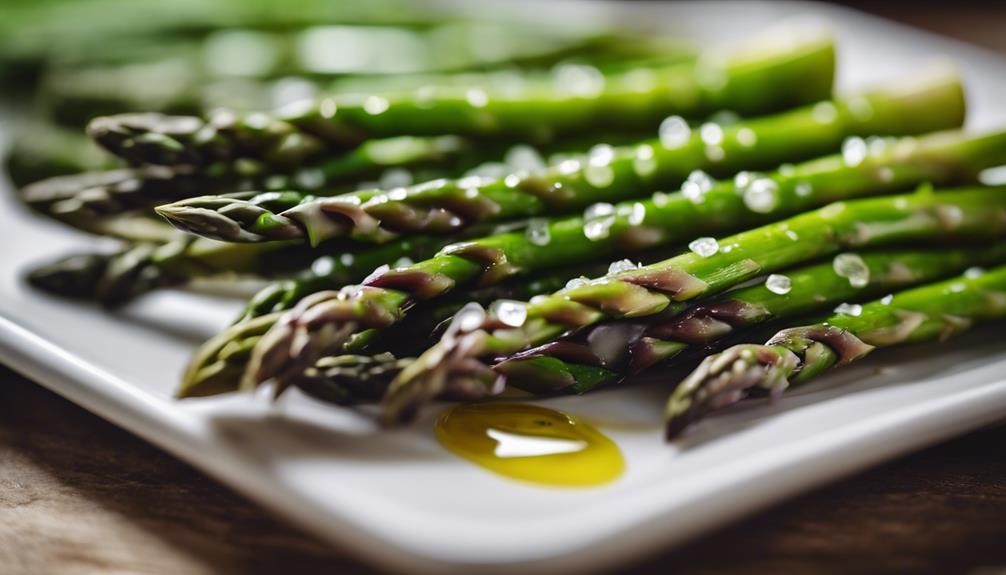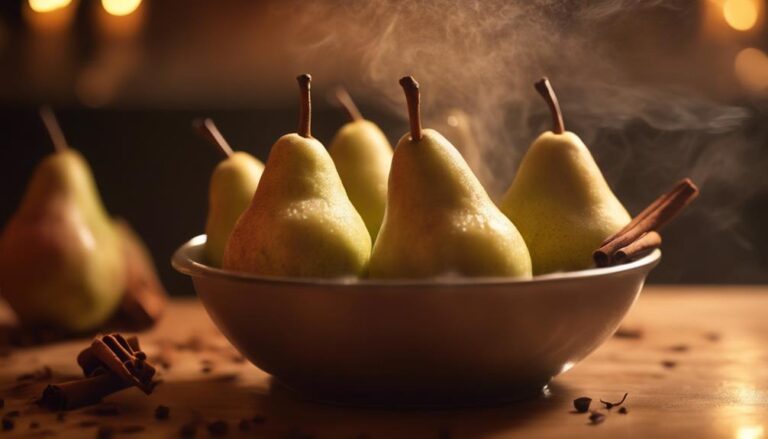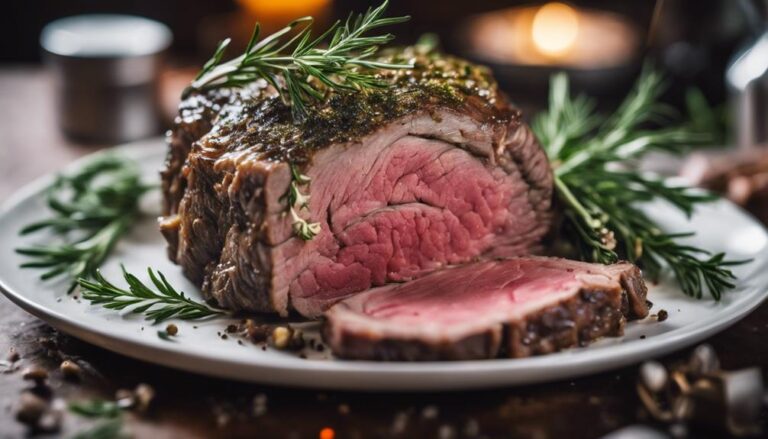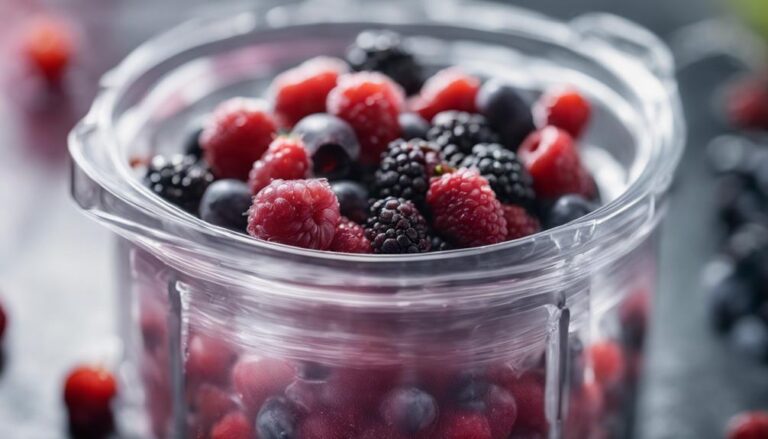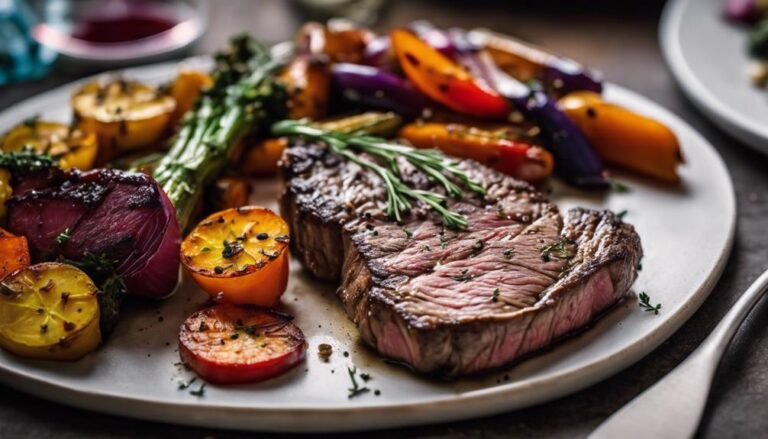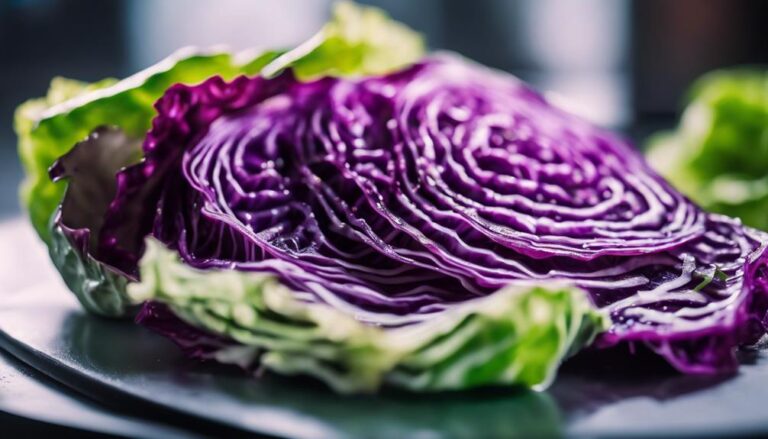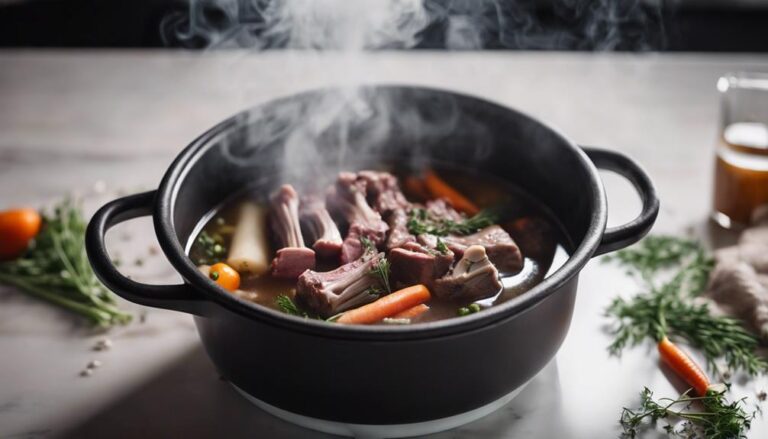Sous Vide Roasted Asparagus
Achieve culinary perfection with sous vide roasted asparagus. Sealed for maximum flavor infusion, this method guarantees consistent texture and nutrient preservation. Elevate your dining experience by savoring the enhanced flavors and tender bite of sous vide-cooked asparagus. Ready to take your asparagus dish to the next level?
What You Will Learn Here
- Sous vide ensures precise temperature control for perfectly roasted asparagus.
- Vacuum sealing enhances flavors and nutrients during the cooking process.
- Gentle sous vide cooking results in a tender and crisp texture.
- Experiment with different seasoning and cooking times for optimal flavor.
- Sous vide roasting maintains asparagus's delicate flavor and nutrients better than traditional methods.
Asparagus' Ancient Culinary Roots
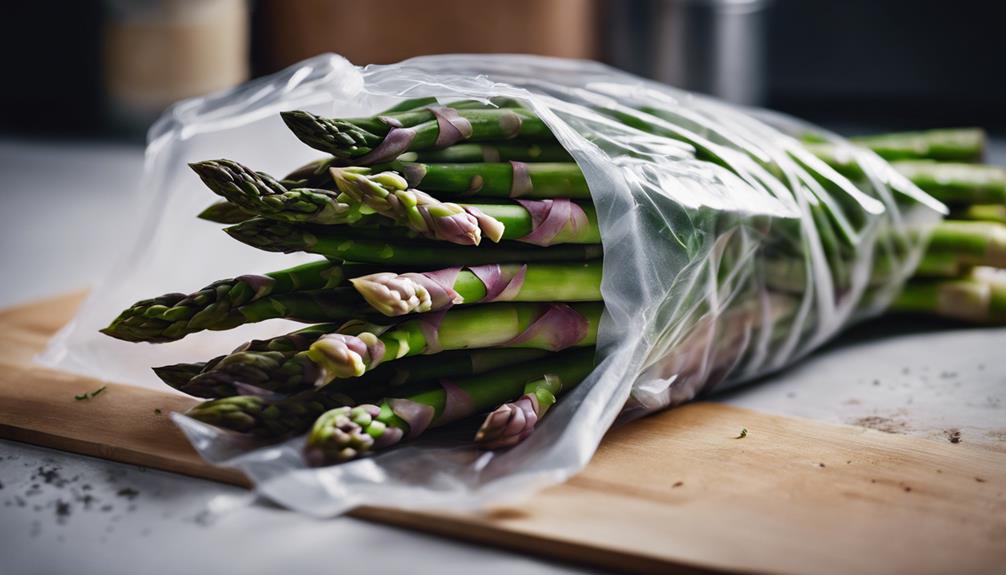
Asparagus holds a rich historical significance in various cultures, dating back to ancient times. Its journey from being a revered delicacy in the Roman Empire to a staple ingredient in modern gastronomy showcases its enduring appeal.
Understanding the evolution of asparagus in history, cooking techniques, and cultural contexts sheds light on its timeless culinary allure.
Asparagus in History
With a history dating back to ancient civilizations, this vibrant vegetable has long been celebrated for its culinary significance. Asparagus wasn't only valued for its delicious flavor but also for its symbolism in various cultures. In ancient Egypt, it was renowned for its medicinal properties and was offered to the gods as a sign of prosperity.
The Greeks and Romans believed asparagus held aphrodisiac qualities and was associated with fertility. Beyond its symbolic meanings, asparagus was appreciated for its nutritional value. Packed with essential vitamins and minerals like vitamin K, folate, and fiber, asparagus has been a staple in diets for centuries.
Its rich history showcases the enduring popularity and importance of this versatile vegetable.
Asparagus in Cooking
In ancient culinary practices, the preparation and consumption of asparagus were intertwined with cultural beliefs and traditions, shaping the significance of this vegetable in historical gastronomy. Asparagus has long been valued not only for its delicate flavor but also for its nutritional benefits.
Rich in vitamins and minerals, asparagus offers a range of health benefits, including being a good source of fiber and antioxidants. Culinary uses of asparagus varied across different ancient civilizations, with some cultures incorporating it into medicinal remedies due to its perceived healing properties.
The distinct flavor profiles of asparagus, often described as earthy and slightly sweet, made it a sought-after ingredient in both savory and sweet dishes, showcasing its versatility in ancient cooking practices.
Asparagus in Culture
Cultures throughout history have integrated this versatile vegetable into their culinary practices, attributing significance to its unique flavor profiles and perceived health benefits.
Asparagus holds symbolic importance in various cultures. In ancient Egypt, it was revered for its medicinal properties and was offered to the gods as a token of worship. The Greeks and Romans considered asparagus a delicacy, associating it with luxury and prosperity.
Asparagus farming dates back centuries, with records indicating cultivation in Ancient Rome and Greece. Its popularity spread across Europe during the Renaissance, becoming a staple in royal feasts. The vegetable's reputation for enhancing well-being and vitality has been documented in folklore and traditional medicine practices, solidifying its place in cultural heritage.
Key Asparagus Components
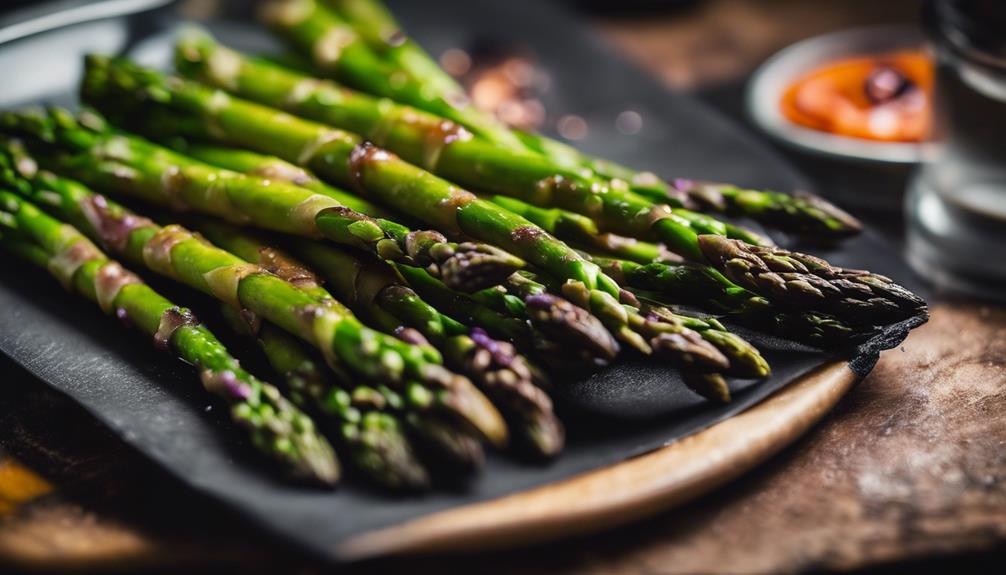
Examining the essential components that define asparagus reveals its unique nutritional profile and culinary versatility. Asparagus isn't only a delicious vegetable but also a powerhouse of nutrients that can elevate any dish it's added to. Here are three key components of asparagus you should consider:
- Nutritional Benefits: Asparagus is a rich source of vitamins A, C, E, and K, as well as folate and fiber. These nutrients contribute to various health benefits, including improved digestion, reduced bloating, and better heart health.
- Flavor Pairings: Asparagus has a delicate and slightly grassy flavor that pairs well with ingredients like lemon, garlic, Parmesan cheese, and prosciutto. These combinations enhance the taste of asparagus dishes, making them more flavorful and enjoyable.
- Seasonal Availability: Asparagus is typically in season during the spring months, making it a popular vegetable for springtime dishes. It's best to enjoy asparagus when it's freshly harvested to savor its crisp texture and vibrant flavor.
Understanding these key components of asparagus can help you appreciate its nutritional value and culinary flexibility in creating delicious dishes.
Tasty Asparagus Creations
Explore the culinary world of asparagus with these delectable creations:
- The Sous Vide Asparagus Delight
- The Sous Vide Asparagus Medley
- The Sous Vide Asparagus Roll-Ups
Each dish offers a unique twist on traditional asparagus recipes, showcasing the versatility of this vibrant vegetable.
Elevate your cooking game and impress your guests with these innovative and flavorful dishes.
Sous Vide Asparagus Delight
To enhance the flavor and texture of asparagus, consider trying out various sous vide techniques that can elevate this vegetable to new heights of culinary delight.
- Precise Temperature Control: Sous vide techniques allow you to cook asparagus at a precise temperature, ensuring it retains its vibrant color and crisp texture.
- Enhanced Flavor Profiles: By vacuum-sealing asparagus with seasonings and aromatics before cooking sous vide, you can infuse the spears with deep, concentrated flavors.
- Tender Yet Crisp Texture: Sous vide cooking preserves the natural crunch of asparagus while tenderizing it perfectly, resulting in a delightful texture that's consistent from end to end.
For a truly elevated experience, consider pairing your sous vide asparagus with a light Sauvignon Blanc or a crisp Pinot Grigio to complement its delicate flavors.
Sous Vide Asparagus Medley
To further explore the culinary possibilities of sous vide cooking with asparagus, let's now investigate creating a delectable assortment of asparagus medleys that are sure to tantalize your taste buds. When using sous vide techniques with asparagus, the flavors intensify, resulting in a vibrant and tender dish. Here are three flavorful asparagus medley ideas to elevate your culinary experience:
- Citrus Herb Infusion: Infuse your asparagus with fresh citrus zest, such as lemon or orange, and herbs like thyme or rosemary to create a zesty and aromatic medley.
- Garlic Parmesan Blend: Combine sous vide asparagus with garlic-infused oil and a sprinkle of Parmesan cheese for a savory and indulgent twist.
- Mushroom Umami Fusion: Pair asparagus with sous vide mushrooms for a rich, umami-packed medley that will satisfy your taste buds.
Sous Vide Asparagus Roll-Ups
For a delectable twist on traditional asparagus dishes, consider creating flavorful Sous Vide Asparagus Roll-Ups, showcasing the versatility and elegant presentation that sous vide cooking can bring to this vegetable favorite.
When exploring asparagus appetizer ideas, these roll-ups offer a delightful option that combines the freshness of asparagus with complementary flavors. To elevate your dish further, mastering asparagus wrapping techniques is crucial to guarantee the perfect roll every time.
Additionally, for those looking to impress guests with sophisticated Sous Vide presentation ideas, arranging these roll-ups neatly on a platter can create a visually stunning effect. Whether served as a standalone appetizer or as part of a larger meal, Sous Vide Asparagus Roll-Ups are sure to be a crowd-pleaser.
Asparagus Sous Vide Techniques
When preparing asparagus using sous vide techniques, you'll benefit from precise temperature control, ensuring that the asparagus cooks evenly and retains ideal texture.
Vacuum sealing the asparagus before cooking offers the advantages of enhanced flavor infusion and preservation of nutrients.
Adjusting the cooking time allows you to achieve the desired level of tenderness while maintaining the vibrant color and fresh taste of the asparagus.
Precise Temperature Control
How can you guarantee exact cooking temperatures for perfectly roasted asparagus using sous vide techniques? Precision cooking offers numerous benefits, ensuring consistent results every time.
Temperature accuracy is vital in sous vide cooking, and there are techniques to achieve this. By setting your sous vide machine to the precise temperature required for asparagus, typically around 185°F (85°C), you can cook your asparagus to perfection.
The water bath provides gentle and even heat distribution, preserving the asparagus's texture and flavor. Using a reliable sous vide device with accurate temperature control is key to achieving the desired results.
With precise temperature control, you can elevate your asparagus dishes to a new level of excellence.
Vacuum Sealing Benefits
To optimize your asparagus sous vide techniques, harness the vacuum sealing benefits for impeccable results. Vacuum sealing plays an essential role in sous vide cooking by removing air from the bag, ensuring maximum contact between the asparagus and the water for efficient heat transfer. This technique minimizes the risk of uneven cooking and helps retain the flavors and nutrients of the asparagus.
By vacuum sealing your asparagus before placing it in the water bath, you create a controlled environment that enhances the overall cooking process. The benefits of vacuum sealing extend beyond just cooking; it also aids in preserving the freshness of the asparagus and prevents any unwanted flavors from seeping in.
Embrace vacuum sealing to elevate your sous vide asparagus to perfection.
Cooking Time Adjustments
For precise sous vide asparagus results, consider fine-tuning your cooking time adjustments to achieve ideal texture and flavor.
When it comes to sous vide cooking, even small changes in cooking time can make a significant difference in the outcome. Temperature variations play an important role in determining the doneness of your asparagus.
For a tender yet crisp texture, aim for a temperature of around 185°F (85°C) for 15-20 minutes. However, if you prefer a softer texture, consider lowering the temperature to 180°F (82°C) and cooking for 25-30 minutes.
To enhance the flavor profile of your asparagus, add seasoning to the vacuum-sealed bag before cooking. Experiment with different cooking times and temperatures to find the perfect combination that suits your preferences.
Final Thoughts
In conclusion, the sous vide method provides a consistent and precise way to roast asparagus, resulting in perfectly cooked and flavorful spears. Sous vide benefits include maintaining the asparagus' natural flavors and nutrients by cooking it in a sealed bag, minimizing nutrient loss. The controlled temperature guarantees that the asparagus is evenly cooked from edge to tip, unlike traditional methods that can lead to uneven results. The gentle cooking process enhances the asparagus's texture, creating a tender yet slightly crisp bite.
Here is a comparison table highlighting the key aspects of sous vide roasted asparagus:
| Aspect | Sous Vide Roasted Asparagus | Traditional Roasted Asparagus |
|---|---|---|
| Flavor | Intensified, natural | Varied, potential loss |
| Texture | Consistently tender | Inconsistent |
| Nutrient Retention | High | Moderate |
| Cooking Time | Longer but precise | Shorter but less controlled |
Frequently Asked Questions
Can Sous Vide Asparagus Be Frozen for Later Use?
Yes, you can freeze sous vide asparagus for later use. Employing sous vide techniques guarantees excellent preservation. Freezing allows for long-term storage, maintaining flavors and textures. Properly sealed, frozen asparagus can be a convenient addition to future dishes.
What Other Vegetables Pair Well With Sous Vide Asparagus?
For flavorful pairings, try combining sous vide asparagus with cherry tomatoes and balsamic glaze. Get creative with recipes like asparagus and mushroom risotto or a revitalizing asparagus and avocado salad. Enjoy experimenting in the kitchen!
Is It Safe to Reuse the Sous Vide Cooking Bags?
When considering bag safety and reusing, it's important to prioritize food storage and preservation. Proper cleaning and inspection can guarantee safety when reusing sous vide cooking bags, extending their lifespan and reducing waste.
Can Sous Vide Asparagus Be Grilled After Cooking?
Yes, you can grill sous vide asparagus after cooking. Enhance its flavor with your favorite seasonings. The grilling technique adds a smoky char that complements the sous vide tenderness, creating a delicious dish that combines the best of both cooking methods.
How Can Sous Vide Asparagus Be Incorporated Into Salads?
To incorporate sous vide asparagus into salads, consider adding flavorful toppings like toasted almonds or feta cheese. Get creative with presentations by arranging the asparagus spears in a starburst pattern or mixing in edible flowers for a visually appealing dish.
Conclusion
To wrap up, sous vide roasted asparagus offers a modern twist on a classic vegetable with ancient culinary roots. By utilizing precise temperature control and sealed bags, this cooking technique allows for ideal flavor retention and texture consistency.
Whether enjoyed as a standalone side dish or incorporated into various recipes, sous vide roasted asparagus is a delicious and versatile option for elevating your culinary creations. Experience the unique taste and benefits of this innovative cooking method today.
